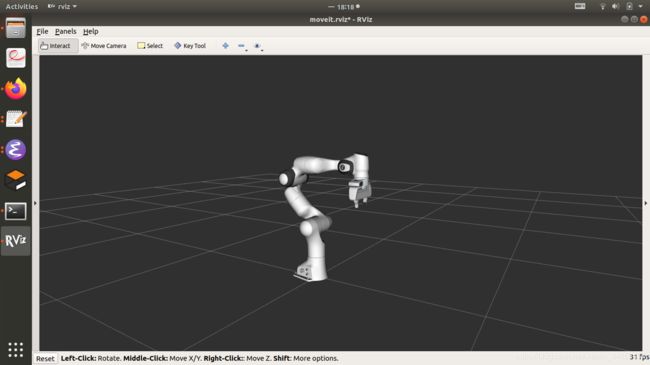07轨迹规划仿真 ——————ROS下UR10机器人实现直线和圆弧笛卡尔空间轨迹规划
0.前言
以下引用:摘自两个月前我的笔记
但是我已经都不记得啥了,加上我当时仿真用的是UR5,但是我现在仅有一台UR10,你可以先将前言部分划过,往下看。
我本篇blog主要内容是:ROS下Rviz联合Momeit实现UR10机器人的直线和圆弧轨迹规划
如果你在实现过程出现bug,可以去看我上边的笔记摘抄,应该有大部分bug的处理方法,希望今天我不会再一次处理他们。
2020/12月轨迹规划学习笔记
一、直线轨迹规划的实现
1.思路:通过moveit的官方文档,实现ur5机器人在rviz+moveit下的笛卡尔空间的直线和圆弧轨迹规划,我想做平面的
2.运行panda机器人的c++文件
roslaunch panda_moveit_config demo.launch
roslaunch moveit_tutorials move_group_interface_tutorial.launch
3.更改.cpp文件move_group_interface_tutorial.cpp
①中间若是目标节点不在工作空间,会出现轨迹规划失败
②四元数的定义
个四元数可以表示为q = w + xi + yj + zk, 给定一个单位长度的旋转轴(x, y, z)和一个角度θ。对应的四元数为:q=((x,y,z)sinθ2, cosθ2)
③这个.cpp文件实现蛮多功能的呢
PTP(两种实现方法)→路径限制的PTP →cartesian 路径规划 →抓取或者松开物体 →避障碍物规划
4.根据panda的c++控制文件写一个ur5的
新建文件路径为ws_moveit/src/moveit_tutorials/doc/move_group_interface
①先把ur5_e_moveit_config功能包弄过来,看看是不是可以正常运行
报错:No such file or directory: /opt/ros/melodic/share/ur_description/urdf/ur5.urdf.xacro
原因:之前的share处的ur5描述文件被我更改过
解决:cd /opt/ros/melodic/share/
sudo rm -rf ur_description/
sudo cp -rf ~/catkin_UR/src/universal_robot/ur_description/* /opt/ros/melodic/share
(注意这行代码是把ur_description下的文件夹复制到share路径下,所以我稍微手动处理了一部分)
备注:这个部位我应该误删除了share下的文件,导致出现以下报错(catkin build 失败)
CMake Error at /opt/ros/melodic/share/kdl_parser/cmake/kdl_parserConfig.cmake:197 (find_package):
Could not find a package configuration file provided by “urdf” with any of
the following names:urdfConfig.cmake urdf-config.cmake Add the installation prefix of "urdf" to CMAKE_PREFIX_PATH or set“urdf_DIR” to a directory containing one of the above files. If
“urdf” provides a separate development package or SDK, be sure it
has been installed.解决:由于这个ROS我越处理出现的问题越多,我最后决定重装ROS正好温习一下(微笑) 会把安装ROS以及各个插件的流程放在“二、”中
②上文中①我把/opt/ros/melodic改出问题来了,所以重新装了ros和moveit 运行ur5的demo.launch
要先确保安装了ur机器人,这样share文件夹下可以找到ur_description②添加c++文件,用moveit控制ur5做直线轨迹规划
添加ws_moveit/src/moveit_tutorials/doc/move_group_interface/launch/move_group_interface_ur5.launch
添加ws_moveit/src/moveit_tutorials/doc/move_group_interface/src/move_group_interface_ur5.cpp
修改ws_moveit/src/moveit_tutorials/doc/move_group_interface/Cmake.lists
在结尾加上三行 基于.cpp生成devel和build下的可执行文件 catkin build 运行c++的可执行文件:
roslaunch ur5_moveit_config demo.launch
二、卸载和安装ROS
1.卸载 sudo apt-get remove ros-*
2.安装 1)安装ROS设置源: sudo sh -c ‘. /etc/lsb-release && echo “deb
http://mirrors.ustc.edu.cn/ros/ubuntu/ $DISTRIB_CODENAME main” >
/etc/apt/sources.list.d/ros-latest.list’ 设置秘钥:sudo apt-key adv
–keyserver keyserver.ubuntu.com --recv-keys F42ED6FBAB17C654 安装ROS: sudo apt-get update sudo apt-get install ros-melodic-desktop-full
初始化rosdep: sudo apt install python-rosdep2 sudo rosdep init
如果这个位置还是报错打不开网页 尝试: #打开hosts文件 sudo gedit /etc/hosts #在文件末尾添加
151.101.84.133 raw.githubusercontent.com #保存后退出再尝试 rosdep update 安装rosinstall: sudo apt-get install python-rosinstall
python-rosinstall-generator python-wstool build-essential添加环境配置 echo
“source /opt/ros/melodic/setup.bash” >> ~/.bashrc source ~/.bashrc
备注:注意要是想打开bashrc 命令为 gedit ~/.bashrc 更改之后要生效需要source ~/.bashrc sudo
apt-get install ros-melodic-desktop 测试:roscore 2)安装moveit
安装catkin的build系统: sudo apt-get install ros-melodic-catkin
python-catkin-tools 安装moveit: sudo apt install ros-melodic-moveit
打开你的工作空间: cd ~/ws_moveit/src rosdep install -y --from-paths .
–ignore-src --rosdistro melodiccd ~/ws_moveit catkin config --extend /opt/ros/${ROS_DISTRO}
–cmake-args -DCMAKE_BUILD_TYPE=Release catkin build
1.通信建立
1.1先下载catkin_UR功能包和ws_moveit功能包(我希望你是一个懂得很多道理的人儿了,比如怎么下载这两个功能包)
1.2检测ws_moveit功能包是否正常
roslaunch panda_moveit_config demo.launch
roslaunch moveit_tutorials move_group_interface_tutorial.launch

 我这个代码我改过(所以我的运行结果是写王字),我把他原来的官方教程网址放在下边,你要是还没接触,并且以后要用moveit的话可以先学一下
我这个代码我改过(所以我的运行结果是写王字),我把他原来的官方教程网址放在下边,你要是还没接触,并且以后要用moveit的话可以先学一下
http://docs.ros.org/en/melodic/api/moveit_tutorials/html/doc
1.3.添加UR10机器人功能包
这个地方我们用了两个官方教程
1)UR功能包,使用rviz的面板控制ur机器人的运动
2)moveit功能包,提供了C++和Python借口控制panda机器人做轨迹规划
因为目标是实现moveit的c++借口控制UR10机器人实现直线和圆弧轨迹规划
所以进行如下操作
①要先确保安装了ur机器人功能包,这样share文件夹下可以找到ur_description
将ur10_moveit_config复制到ws_moveit/src下
②添加c++文件,用moveit控制ur10做直线轨迹规划
添加ws_moveit/src/moveit_tutorials/doc/move_group_interface/launch/move_group_interface_ur10.launch
<launch>
<node name="move_group_interface_ur10" pkg="moveit_tutorials" type="move_group_interface_ur10" respawn="false" output="screen">
</node>
</launch>
③添加ws_moveit/src/moveit_tutorials/doc/move_group_interface/src/move_group_interface_ur10.cpp
#include ④修改ws_moveit/src/moveit_tutorials/doc/move_group_interface/Cmake.lists 在结尾加上三行 基于.cpp生成devel和build下的可执行文件
add_executable(move_group_interface_ur10 src/move_group_interface_ur10.cpp)
target_link_libraries(move_group_interface_ur10 ${
catkin_LIBRARIES} ${
Boost_LIBRARIES})
install(TARGETS move_group_interface_ur10 DESTINATION ${
CATKIN_PACKAGE_BIN_DESTINATION})
install(DIRECTORY launch DESTINATION ${
CATKIN_PACKAGE_SHARE_DESTINATION})
⑤终端输入
cd ~/ws_moveit
source ./devel/setup.bash
catkin build
⑥以上搭建完通信了
检验一下
cd ~/ws_moveit
source ./devel/setup.bash
roslaunch ur10_moveit_config demo.launch
打开一个新的tab
cd ~/ws_moveit
source ./devel/setup.bash
roslaunch moveit_tutorials move_group_interface_tutorial.launch
2.实现直线轨迹规划(PTP)
修改ws_moveit/src/moveit_tutorials/doc/move_group_interface/src/move_group_interface_ur10.cpp代码如下
#include 3.圆弧轨迹规划
(这个坑我明天会填的,会的~)
